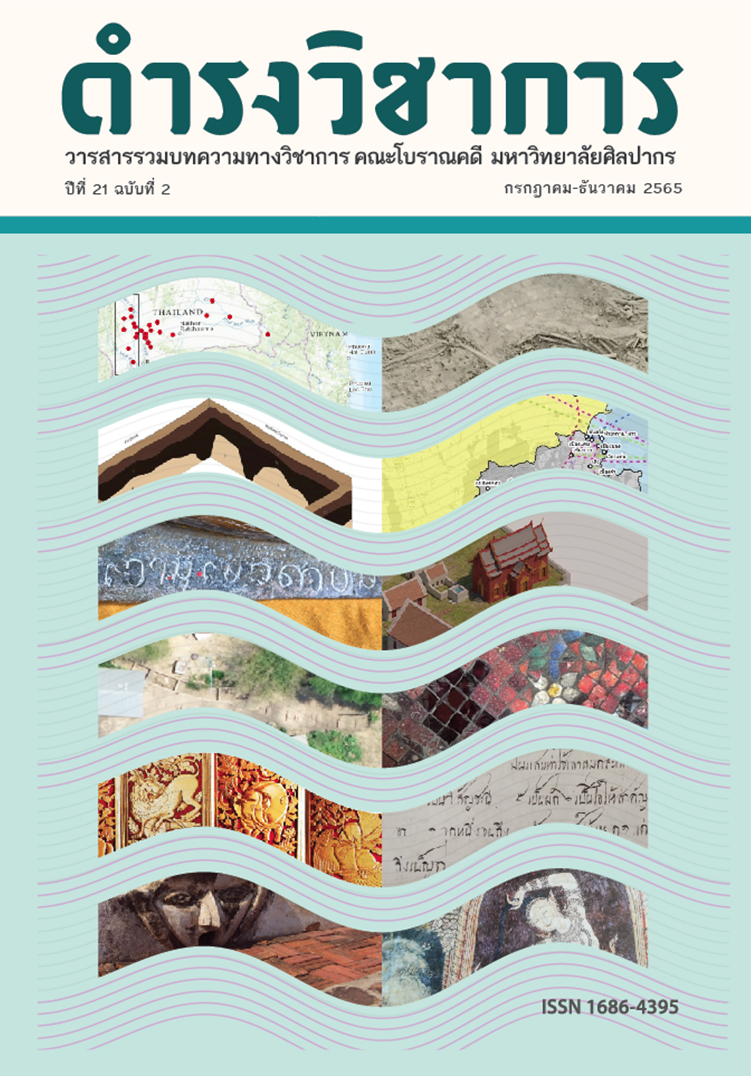Interpretation of the Four animal Symbols and Other Sculptures on the Stupa of Wat Bowonniwet Vihara according to the Xiyouji Literature
Keywords:
Xiyouji, Stupa of Wat Bowonniwet Vihara, Four animals, King MongkutAbstract
The purpose of this research was to interpret the four animal symbols and other sculptures in bronze and on wood door panels in accordance with Xiyouji literature. On this view, the horse refers to the Xuanzang's dragon horse, while the lion, elephant and eagle refer to three demonic kings. These four animals connote the support which assisted Xuanzang to successfully bring the Dharma to The Tang Emperor: a horse carrying a large number of Dharma scrolls, the Buddha and the two Bodhisattvas who defeated three demonic kings. Of the four animal carvings on the wood door panels, the horse represents the French, the lion represents the British, the elephants refer to the people of Ceylon, and the eagle stands for the American. King Mongkut used the Xiyouji plot to compare the methods of Buddhist propagation. The Tang Emperor used the handwritten method to copy the scripture’s manuscript, whereas the King Mongkut used the more efficient typing method. The four animals represent friends from four nations, Ceylon, France, England and the United States of America who support their royal duties.
References
ภาษาไทย
คณะกรรมการอำนวยการฯ, 2546. ศิลปกรรมวัดบวรนิเวศวิหาร. กรุงเทพฯ: วัดบวรนิเวศวิหาร, จัดพิมพ์ใน วโรกาสงานฉลองพระชนมายุ 90 พรรษา สมเด็จพระญาณสังวร สมเด็จพระสังฆราช สกลมหาสังฆปริณา ยก วันที่ 3 ตุลาคม พุทธศักราช 2546.
คณะสงฆ์วัดพระเชตุพน, 2554. ประชุมจารึกวัดพระเชตุพน. กรุงเทพฯ: อมรินทร์พริ้นติ้งแอนด์พับลิชชิ่ง.
จอมเกล้าเจ้าอยู่หัว, พระบาทสมเด็จพระ, 2475. สำเนาแลคำแปลพระราชหัตถเลขาพระบาทสมเด็จพระจอม เกล้าเจ้าอยู่หัวก่อนเถลิงถวัลยราชสมบัติ รวมในสมุดนี้ 4 ฉบับ. (แปลโดย หม่อมเจ้าพรพิมลพรรณ รัชนี). พิมพ์ในงานพระราชทานเพลิงพระศพพระเจ้าบรมวงศ์เธอ พระองค์เจ้ากัญจนากร ณ พระเมรุวัด เทพศิรินทราวาส พุทธศักราช 2475. พระนคร: โสภณพิพรรฒธนากร. (ต้นฉบับเขียนเมื่อปี พ.ศ. 2391, ภาษาอังกฤษ)
ชลภูมิ บรรหาร, 2552. “ความทันสมัยทางการเมืองตามแนวพระราชดำริในพระบาทสมเด็จพระจอมเกล้าเจ้าอยู่หัว.” สารนิพนธ์ปริญญาการศึกษามหาบัณฑิต สาขาวิชาประวัติศาสตร์ มหาวิทยาลัยศรีนครินทรวิโรฒ.
ปติสร เพ็ญสุต, 2557. “พระบาทสมเด็จพระจอมเกล้าเจ้าอยู่หัวกับความเป็นศูนย์กลางจักรวาลเชิงสัจนิยม ณ พระเจดีย์ประธานวัดบวรนิเวศวิหาร.” ดำรงวิชาการ 13 (1): 179-124.
วชิรญาณวโรรส, สมเด็จพระมหาสมณเจ้า กรมพระยา, 2465. ตำนานวัดบวรนิเวศวิหาร. พระนคร: หอพระสมุด วชิรญาณ, พิมพ์โดยพระบรมราชโองการในงานถวายพระเพลิงพระศพ สมเด็จพระมหาสมณเจ้าฯ ที่พระ เมรุท้องสนามหลวง พุทธศักราช 2465.
วัดบวรนิเวศวิหาร, 2551. สมุดภาพพระเจดีย์วัดบวรนิเวศวิหาร. กรุงเทพฯ: โรงพิมพ์สุรวัฒน์.
ศักดิ์ชัย สายสิงห์, 2556. พุทธศิลป์สมัยรัตนโกสินทร์ พัฒนาการของงานช่างและแนวคิดที่ปรับเปลี่ยน. กรุงเทพฯ: เมืองโบราณ.
ศิริพงศ์ พยอมแย้ม, 2530. การพิมพ์เบื้องต้น. กรุงเทพฯ: โอเดียนสโตร์.
สุภัทร ชัยวัฒนพันธุ์, 2549. ประวัติวรรณคดีจีน. กรุงเทพฯ: สุขภาพใจ.
สุรพล ดำริห์กุล, 2557ก. “พระพุทธศาสนาลังกาวงศ์กับการปรากฏขึ้นของเจดีย์แบบช้างล้อมในสุโขทัยและ ล้านนา.” ข่วงผญา 9: 172-202.
____________, 2557ข. “เจดีย์ช้างล้อมและเจดีย์สิงห์ล้อมในกรุงศรีอยุธยา.” วารสารวิจิตรศิลป์ 5 (2): 101- 131.
สุรสิทธิ์ อมรวณิชศักดิ์, 2553. “ภาพปูนปั้นเล่าเรื่องไซอิ๋วในวัดบวรนิเวศวิหาร.” วารสารเอเชียตะวันออก ศึกษา 15 (1): 11-38.
โหง่วเส่งอึง, 2547. ไซอิ๋วพงศาวดารจีน. นนทบุรี: สำนักพิมพ์ศรีปัญญา.
ภาษาอังกฤษ
Wu Cheng'en, 2012. The journey to the West (Vols. 1-4). (Translated by Anthony C. Yu). Chicago: University of Chicago Press. (Original work published ca. 1500-ca. 1582, In Chinese)
Downloads
Published
Issue
Section
License
Copyright (c) 2022 Damrong Journal of The Faculty of Archaeology Silpakorn University

This work is licensed under a Creative Commons Attribution-NonCommercial-NoDerivatives 4.0 International License.
บทความนี้เป็นผลงานของข้าพเจ้าแต่เพียงผู้เดียว และ/หรือเป็นผลงานของข้าพเจ้าและผู้ร่วมงาน ตามชื่อที่ระบุในบทความจริง และเป็นผลงานที่มิได้ถูกนำเสนอหรือตีพิมพ์ที่ใดมาก่อน





